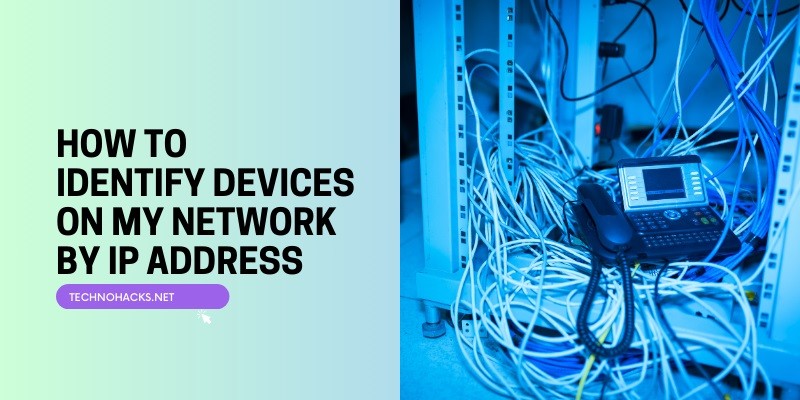Last Updated on May 5, 2025 by Jim C.
In today’s interconnected world, understanding and managing the devices connected to your network is crucial for maintaining security, optimizing performance, and troubleshooting issues. This article will guide you through the process of identifying devices on your network using their IP addresses, providing you with the knowledge and tools necessary to keep your network secure and efficient.
Why Identifying Devices is Important
Network Security
Identifying devices on your network is paramount for maintaining robust security. Unauthorized devices can pose significant risks, including potential data breaches and malware infections. By regularly monitoring and identifying connected devices, you can quickly detect and prevent unauthorized access, ensuring that only trusted devices have access to your network resources.
Network Performance
The number of devices connected to your network can significantly impact its performance. As more devices join, bandwidth becomes shared, potentially leading to slower speeds and increased latency. By identifying and managing the devices on your network, you can optimize performance, allocate resources more effectively, and ensure a smooth user experience for all connected devices.
Troubleshooting
When network issues arise, being able to identify devices quickly can be invaluable for diagnosing and resolving problems. By pinpointing which devices are connected and their respective IP addresses, you can isolate problematic devices, identify unusual behavior, and address connectivity issues more efficiently.
Methods to Identify Devices by IP Address
Using Router’s Web Interface
One of the most straightforward methods to identify devices on your network is through your router’s web interface. Here’s how to do it:
- Open a web browser and enter your router’s IP address (commonly 192.168.1.1 or 192.168.0.1).
- Log in using your router’s admin credentials.
- Navigate to the “Device List” or “Connected Devices” section.
- View the list of connected devices along with their IP addresses, MAC addresses, and sometimes device names.
This method provides a quick overview of all devices currently connected to your network, making it easy to spot unfamiliar or unauthorized devices.
Using Command Prompt (Windows)
For Windows users, the Command Prompt offers a powerful way to identify devices on your network:
- Open Command Prompt by typing
cmdin the search bar. - Type
arp -aand press Enter to view a list of IP addresses and their corresponding MAC addresses. - Use
ping -a [IP address]to resolve the IP address to a hostname, if available.
These commands provide detailed information about connected devices, including their IP and MAC addresses, which can be crucial for identifying unknown devices.
Using Terminal (Linux/Mac)
Linux and Mac users can use similar commands in the Terminal:
- Open Terminal.
- Type
arp -ato display a list of devices connected to your network. - Use
ping -a [IP address]for further details.
These commands work similarly to their Windows counterparts, offering a comprehensive view of connected devices.
Using Network Scanning Tools
For more advanced users or those managing larger networks, network scanning tools can provide a more comprehensive and automated approach to device identification:
- Advanced IP Scanner: This free tool scans your network and provides a detailed list of connected devices, including their IP addresses, MAC addresses, and even shared folders.
- Angry IP Scanner: An open-source, cross-platform network scanner that can quickly scan IP addresses and ports.
- Nmap: A powerful, versatile network scanning tool available for Linux, Mac, and Windows. Use the command
nmap -sP 192.168.1.0/24to scan the entire subnet.
These tools offer more in-depth information and can be particularly useful for IT professionals or those managing complex networks.
Steps to Take After Identifying Devices
Identifying Unknown Devices
Once you’ve compiled a list of connected devices, it’s important to identify any unknown or suspicious entries:
- Cross-reference MAC addresses with known devices in your network.
- Use online MAC address lookup tools to identify the manufacturer of unknown devices.
- If you find a device you can’t identify, consider temporarily disconnecting it from your network until you can verify its legitimacy.
Securing Your Network
After identifying all devices on your network, take steps to enhance your network security:
- Change your Wi-Fi password regularly, using a strong combination of uppercase and lowercase letters, numbers, and special characters.
- Enable WPA3 encryption if available on your router, as it offers the strongest security for wireless networks.
- Disable WPS (Wi-Fi Protected Setup) to prevent potential vulnerabilities that could allow unauthorized access.
Monitoring and Managing Devices
Implement a routine for monitoring and managing devices on your network:
- Regularly check the list of connected devices using your preferred method.
- Use parental controls or guest networks to limit access for certain devices or users.
- Consider using network management software for larger networks to automate the process of device identification and monitoring.
Conclusion
Identifying devices on your network by IP address is a fundamental skill for maintaining network security and performance. By utilizing router interfaces, command-line tools, and network scanning software, you can effectively manage and secure your network. Regular monitoring and proactive security measures will help ensure that your network remains safe, efficient, and free from unauthorized access.

